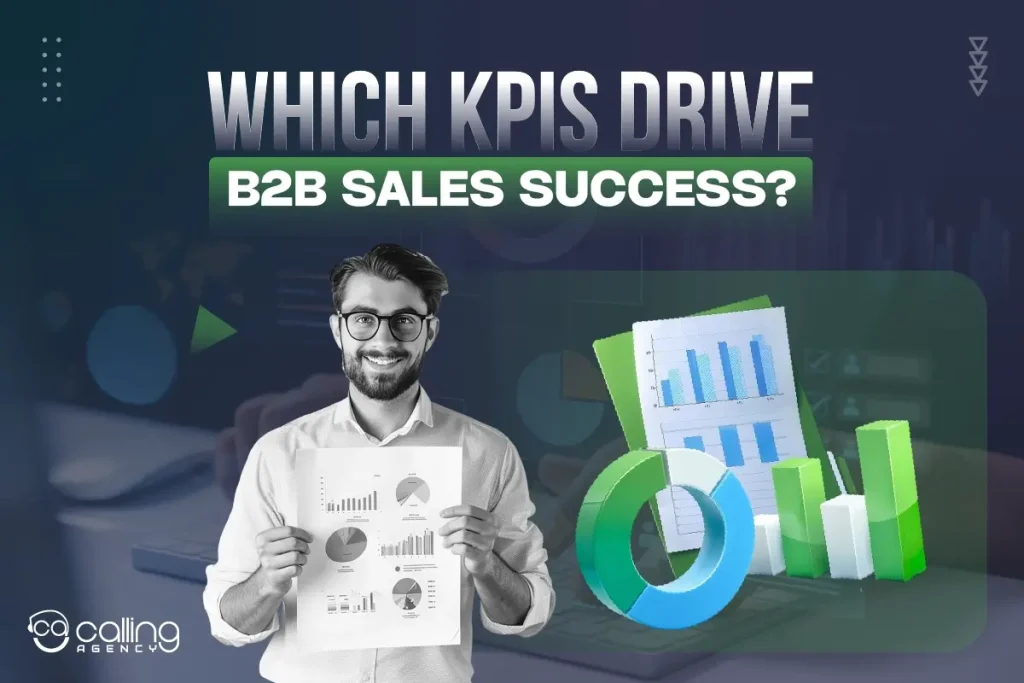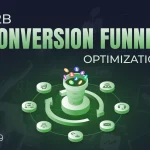B2B sales KPI, or key performance indicators, are numerical measurements that assess your sales team’s performance and the effectiveness of your sales strategies.
You can combine various B2B sales and lead generation KPIs to optimize your marketing efforts, like customer acquisition and retention, productivity and activity, revenue performance, etc. You can quickly transform your leads into loyal customers with the help of these indicators. They not only improve your sales productivity but also make sure that your sales pipeline is healthy and strong, so that your revenue is increasing.
In this blog, we’ll explore some of the essential B2B sales KPIs, as well as how to choose the right KPI that can drive potential growth and success for your business.
Core B2B Sales KPIs That Drive Success
A data-driven mindset, combined with your sales KPIs, is crucial for your B2B company. They highlight how well your company is performing towards its business objectives.
You can use these core metrics like customer acquisition and retention, account and relationship, lead conversion, cost per acquisition, etc, to understand which KPIs drive B2B sales success.
These numerical values demonstrate how effectively your sales team is working towards important goals, like converting your B2B sales leads to customers or growing revenue.
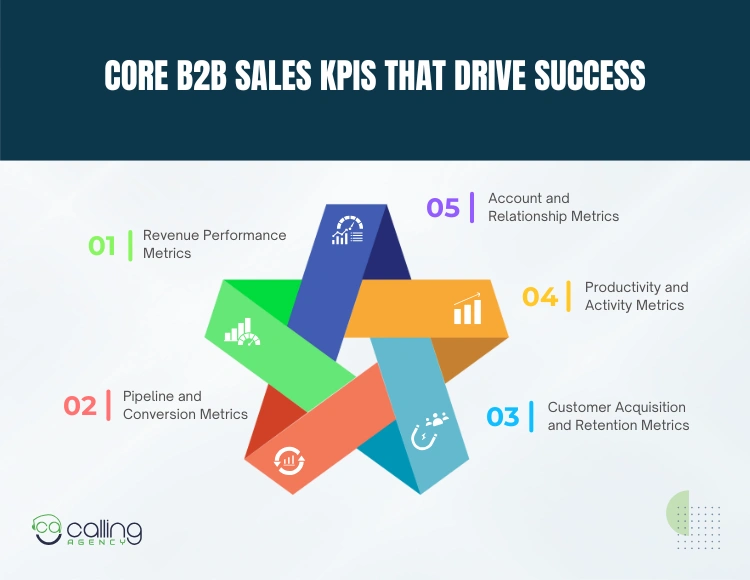
Revenue Performance Metrics
Revenue metrics are the measurements that assess the revenue of your company. Understanding your company’s revenue performance metrics can provide you with a thorough picture of your financial past and present. These can include your per customer revenue, increase in revenue, annual and monthly sales revenue, and more.
Customer Lifetime Value
Generally, it costs five to seven times more to convert a new customer compared to an old one.
However, the difference between acquisition and retention for your company depends on your customers’ lifetime value.
To find your company’s customer lifetime value, you can use the following formula.
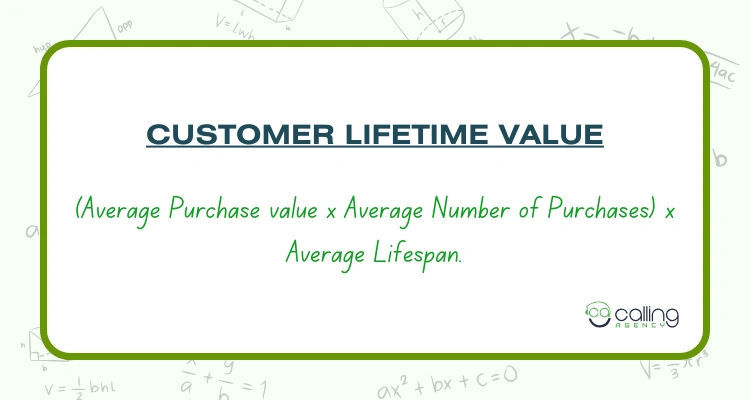
Customer Lifetime Value = (Average purchase value x Average number of purchases) x Average lifespan.
For example, you have a B2B software company that sells cloud-based management tools. Its average purchase value is $1500 per purchase, purchase frequency is 12 times per year, and the average customer lifespan is 3 years. Then, your customer life value will be:
CLV = $1500 (average purchase) x 12 (number of purchases) x 3 (years) = $54000 per customer.
Your customer lifetime value is $54,000 per customer, which is good for a SaaS company.
Lead Conversion Rate
Your lead conversion rate is basically the percentage of your leads that successfully convert into buying customers.
You can take a look at the following formula to figure out your lead conversion rate,
Lead Conversion Rate = (number of leads converted / number of leads generated) x 100
Let’s consider your small software company has generated 700 leads over a month because of many marketing activities, and 50 of these leads have ultimately purchased your software subscription. Then, your Lead Conversion Rate is:
LCR = (80/700) x 100 = 11.42%
It shows that your company has an 11% lead conversion rate, which is basically considered a good conversion rate for a SaaS company.
Annual/Monthly Recurring Revenue
Your annual or monthly recurring revenue is the revenue that your business can expect from its customers each year or month. It is especially helpful for forecasting sales and a best practice for those companies that operate with a subscription model.
You can use this formula to find out your annual or monthly recurring revenue.
Annual recurring revenue = (new subscriber revenue + existing subscriber revenue + upgraded subscriber revenue) – (churned subscriber revenue lost + downgraded subscriber revenue lost).
Monthly recurring revenue = (new subscriber revenue + existing subscriber revenue + upgraded subscriber revenue) – (churned subscriber revenue lost + downgraded subscriber revenue lost)./12.
Let’s say you have a startup B2B company and started the year with $10,000,000 in revenue. It has gained $500,000 in new annual subscribers, earned $200,000 in expansion revenue (from upgrades), lost $100,000 due to churned subscribers, and $50,000 from downgrades after launching new cloud-based tools. Your calculation will be:
ARR= ($10,00,000+$500,000+$200,000)- ($100,000+$50,000)
ARR = 17,00,000-1,50,000= $15,50,000
Now, your MRR will be:
MRR= $15,50,000/12= $1,29,166.67
For your startup company, your ARR is $15,50,000 and MRR is $1,29,166.67, which is considered good in the industry.
Revenue Growth Rate
Your revenue growth rate is the increase in your company’s total revenue over a certain time. This metric is important for both your sales forecasting and your business’s financial performance.
You can figure out your revenue growth rate by using the given formula
Revenue Growth Rate = ( Current period revenue- previous period revenue) / (previous period revenue) x 100
Let’s consider your tech company’s previous growth rate was $10,00,000 in the first quarter of 2024. Now, the current growth rate is $12,00,000 in the first quarter of 2025. So the calculation is :
Revenue Growth Rate= ($1200000-$100000) / 1000000)x 100
Revenue Growth Rate= 20%
Your revenue growth rate is 20%. Your tech company has an overall solid performance over the year.
Pipeline and Conversion Metrics
Pipeline metrics are the major components that your sales teams need to understand and track, and every team member in your company should be aware of them. After all, the pipeline is the ultimate journey that every lead has to go through.
Number of Opportunities
This metric represents the qualified contacts who have actively shown interest in your offerings, engaged with your team, and are eager to explore more.
You can figure out the number of opportunities in your sales pipeline with this formula:
Number of Opportunities = Total Count of Active Sales Opportunities
For example, if you have 12 new deals, 6 in negotiation, and 5 with proposals sent. Then, you have
Number of Opportunities = 12+7+5
Number of Opportunities = 12+7+5= 24
You currently have 24 sales opportunities in your sales pipeline.
Pipeline Value
This metric is generally the cumulative worth of all deals within your sales pipeline to determine the total value of the pipeline. A higher value indicates your increased revenue potential.
You can easily find out your pipeline value with the following formula.
Pipeline Value = Σ(Deal Value x Probability of Closing)
For instance, you have two deals in your sales pipeline. One deal is worth $10000 at a 50% probability, and another one is worth $60000 at a 70% probability of closing. Your calculation would be:
PV= ( $10000 x 0.5) + ( $60000 x 0.7)
PV= $5000 + 42000 = $47000
Your pipeline value is $47000.
Average Deal Size
The mean value of your successful deals affects both sales strategies and the pace of your pipeline.
You can find out your average sales deal size with the following formula.
Average Deal Size = Total value of Won deals / Number of Won deals
Let’s say you have 3 deals in a month. One worth $5000, the second one worth $7500, and another one worth $10000. Your calculation will be:
Average Deal Size = $5000+7500+10000/ 3
Average Deal Size =$22000/3 = $7333
Your average deal size is $7333. Depending on the SaaS industry, it is considered a good average-sized deal.
Opportunity to Win Rate
This metric works like a mirror of your sales process quality. It expresses the successful conversion of leads into sales, whether it is monthly, quarterly, or annually.
You can easily calculate your opportunity-to-win rate with this formula.
Opportunity to Win Rate = (Number of Opportunities Won / Total Number of Opportunities) x 100
Let’s say you had 60 sales opportunities over a period, and 15 of them were won. Your calculation would be:
Opportunity to Win Rate= (15/60) x 100 = 25%
Your opportunity-to-win rate is 25%, which is generally considered a good rate on average in the B2B industry.
Conversion metrics essentially represent the percentage of your users who have completed a desired action. For example, you have purchased a product, downloaded an app, or signed up for an email form.
Conversion Rate
Your conversion rate is the percentage of your users who have completed a specific action, like making a purchase. It qualifies depending on your business’s goals and needs.
You can analyze your conversion rate by using the given formula.
Conversion Rate = (Number of Conversions / Total Number of Visitors) x 100
For example, your software company’s website has received 800 unique visitors, and 30 of them have completed an email sign-up form. Now, your calculation would be:
CR = (30/800) x 100= 3.75%.
A 3.75% conversion rate for your software company is considered a good to above-average rate in the SaaS industry.
Click-Through Rate
CTR generally shows how many users have clicked on a link, ad, or CTA. It also provides you with the clearest signs that your content or ad is performing well and generating impressions.
You can easily measure your click-through rates by the given formula.
Click-Through Rate = (Total clicks / Total impressions) x 100
Let’s say your startup B2B company has started the year with a $10,00,000 revenue, gained $500,000 in new annual subscribers, earned $200,000 in expansion revenue (upgrades), lost $100,000 from churned subscribers, and $50,000 from downgrades after launching new cloud-based tools. Your calculation will be:
CTR (150/1000) x 100 = 15%.
Your CTR is 15%, which is really good for a B2B software company.
Bounce Rate
This metric, in general, refers to the proportion of users who land on your page and leave without taking any action. They neither click nor scroll, simply leave the website.
You can find out your website’s bounce rate with this formula. Then you can understand which part of your content needs improvement.
Bounce Rate = (Total visitors who left without any interaction/ Total visitors to your page) x 100
Let’s say your company has 700 visitors on its product landing page and 200 left without interacting further. Your calculation would be:
Bounce Rate = (150/700) x 100 = 21%.
Your bounce rate is 21.42%, which is technically a low bounce rate and indicates that your website is performing well.
Sales Conversion Rate
This metric tells how well you can turn your visitors or leads into paying customers. It’s especially essential for Saas and B2B sales-driven funnels.
You can measure your sales conversion rate with this formula and find whether you have a high or low conversion rate.
Sales Conversion Rate = (Number of Sales / Total leads or visitors) x 100
Suppose your software company has generated 850 qualified leads through various B2B marketing efforts and acquired 100 new customers. SO the calculation will be:
Sales Conversion Rate = (100/850) x 100 = 11.76%
Your sales conversion rate is 11.76%, which is considered good compared to the industry benchmark.
Customer Acquisition and Retention Metrics
Fastest-growing businesses like Saas under $50M in revenue have an increase of 87% in acquiring new customers over a year. That’s why customer acquisition metrics have notably become one of the most important metrics.
Cost Per Acquisition
CPA helps you to measure your total marketing cost of acquiring a lead from marketing activities. It’s mainly a key element in your customer acquisition and growth strategy.
You can easily calculate your CPA using the following formula.
CPA = Total media spend/ Conversions
For example, your B2B company has spent $ 30,000 on various paid channels, including LinkedIn, Google search ads, and sponsored content. During the time of the campaign, you’ve got 15 new B2B clients who signed up for their software. Your calculation would be:
CPA = $30000/15 = $2000.
It shows that your company is spending an average of $2,000 on media advertising to get each new client.
Return on Ad Spend (ROAS)
ROAS is a metric that provides you with a value indicating how well your campaigns are performing. It’s about measuring your revenue generated for every $ of marketing budget spent.
You can easily calculate your ROAS for your digital marketing campaign using the given formula.
ROAS = (Revenue generated by ads/cost of ads) x 100
Let’s say your company is running a campaign that generates $40,000 worth of revenue, and you have spent $ 15,000 on the campaign to yield this revenue. Your calculation will be:
ROAS = ($40000/$15000) x 100 = 266.66%.
Your campaign has generated a 266.66% ROAS, which is a considerably good performance.
Conversion Rate
CR generally represents the percentage of individuals who have completed a necessary and desired action. You can increase the effectiveness of your customer acquisition strategy by improving your customer conversion rate.
CR = (Number of Conversions / Total Number of Visitors) x 100
For example, your software company’s website has received 1000 unique visitors on its landing page, and 300 of them have completed an email sign-up form to get the newsletter updates. Your calculation would be:
CR = (300/1000) x 100 = 30%.
A 30% conversion rate for your software company is an excellent rate in the SaaS industry.
Lifetime Value (LTV)
LTV measures the average amount that a customer spends during their relationship with your company. It provides a very useful insight about where your business is heading, how well you’re meeting your customers’ needs, and how loyal your customers are to your brand.
To figure out your LTV, you can use the given formula.
Lifetime Value = (Average customer purchase value x Average Customer Frequency x Average customer lifespan)
Let’s say your B2B company has an average annual revenue of $7000 per customer, who purchases 10 times a year for an average of 8 years. Your calculation will be:
LTV= ($7000 x 10 x 8) = $5,60,000.
Your average customer spends $5,60,000 in revenue over the course of their relationship with your brand.
Whereas customer retention metrics will tell you how well your business retains customers and how satisfied your customers are throughout their customer journey with your brand.
These metrics help you determine the revenue that you generated from your existing customers.
Customer Retention Rate
This metric calculates the percentage of your customers who stay with your company over time. It is often used by service businesses like Saas, banking, or telecom companies.
You can understand how effectively your retention strategy is working by evaluating your customer retention rate.
CRR = {(End number of customers- New customers gained)/ Starting number of customers)} x 100
For example, you had 1000 customers on January 1 and 1200 customers on December 31, and gained 500 new customers throughout the year. Your calculation is :
CRR = {(1200-500) / 1000} x 100 = 70%
Your customer retention rate is 70%, which is considerably good for the B2B sector.
Repeat Purchase Rate
Repeat purchase rate, also known as repeat customer rate, measures the percentage of your customers who have returned to buy your product again. It is a great indicator of your customer loyalty.
Here’s the formula that you can use to determine your repeat purchase rate.
RPR = (Number of returning customers/ Number of total customers) x 100
Let’s say your B2B company had 500 active subscribers at the beginning of the quarter, and 60 new subscribers were added during that quarter. At the end of the quarter, there were 540 active subscribers.
Now, the number of your returning customers is determined by subtracting the new customers acquired from the ending customers, which is 540-60= 480. Then, your RPR is:
RPR = (480/500) x 100 = 96%
Your company’s RPR is 96%, which is exceptionally good and indicates a high level of customer satisfaction.
Customer Churn Rate
This metric is also known as user churn rate. It usually tracks the percentage of your customers who leave during a certain time period. It is usually used by Saas and subscription businesses.
You can use the given formula to calculate your customer churn rate.
Customer Churn Rate = ( Number of customers who left/ Total number of customers at the start of the period) x 100.
For example, your company had 1000 customers on January 1, but 300 left before December 31. Then your annual churn rate is:
Customer Churn Rate = (700/1000) x 100 = 30%
Your customer churn rate is 30, which is higher than the industry benchmark and indicates there are significant problems.
Customer Satisfaction Score
CSAT typically measures how satisfied your customer is with your product or service. CSAT surveys usually have a simple 5-point scale or binary happy/sad face option after a customer has received a product or service.
You can use the given formula to simply calculate your CSAT.
Customer Satisfaction Score = (Total positive scores/ Number of respondents) x 100
For example, your company has sent a survey to 100 clients after providing customer service for a new software implementation. Out of 100 responses, 60 clients rated the experience as “ satisfied” and “very satisfied”. So, your calculation will be:
Customer Satisfaction Score = (60/100) x 100 = 60%
Your CSAT is 60, which is not considered good and indicates a portion of your customers are either dissatisfied or neutral.
Productivity and Activity Metrics
Sales productivity quantifies the efficiency and effectiveness of your company’s sales team. These metrics often provide valuable insights into the performance of your sales team, indicating where exactly you’re excelling and where you need to make improvements.
Revenue Per Salesperson
Revenue per salesperson is a simple yet powerful metric that analyzes your average revenue generated by each member of your sales team.
You can simply assess your revenue per salesperson with this straightforward formula.
Revenue per person = Total sales revenue/ Number of salespeople in a team
For example, your small company has generated $3M in the total fiscal year with a total team of 10 salespeople, your calculation will be:
Revenue per person = $30,00,000/10 = $3,00,000
Your revenue per person is $3,00,000, which is exceptionally good industry-wise.
Sales Cycle Velocity
Your sales cycle velocity mainly indicates the speed at which your team converts leads into customers. A faster cycle means your team is closing deals quickly and boosting revenue.
You can determine our sales cycle velocity using this simple formula.
Sales Cycle Velocity = Total number of closed deals/ Total duration of sales cycle
For example, your company closes 15 deals in a 1.5 month period. So, your calculation will be:
Sales Cycle Velocity =15/ 46 days = 0.32 deals per day.
This shows how quickly you’re closing deals each day.
Time to Productivity
This metric indicates how long it takes for a new sales representative to start generating revenue effectively. A shorter time mostly indicates a higher sales productivity.
You can calculate this time by tracking when your new reps start until they reach a performance standard, like closing their first deals. You can reduce this time and make them productive contributors by providing them with strong training programmes and useful resources.
Revenue Per Sales Activity
Your revenue per sales activity exactly tracks the average revenue generated from each of your sales activities, like calls or meetings.
You can measure your revenue per sales activity by using the given formula.
Revenue per sales activity = Total revenue/ Total number of sales activities
Let’s say your software provider company has generated $250,000 from 30 product webinars. Then, your calculation would be:
Revenue per sales activity = $250,000/30 = $8,333 per webinar.
For a software company, your $8333 revenue per sales activity is not a standard figure.
Activity metrics, also known as sales activity metrics, measure the specific actions that your sales representatives perform throughout the sales process.
- Measure your outreach activities with the number of calls you’ve made, the quantity of emails that you’ve sent, or social reaches like LinkedIn connections.
- Track your pipeline-building activities with the number of initial meetings you’ve booked, the percentage of your scheduled meetings, or the number of proposals you’ve created per period.
- Assess your follow-up effectiveness with the percentage of your prospects who have received, your average time of interactions, and your average number of interactions before closing.
Account and Relationship Metrics
Account metrics are your quantifiable measurements that measure the effectiveness and performance of your various business accounts, like customer, marketing, or financial accounts.
Your account metrics can vary depending on the specific business function they’re designed to measure.
Financial Account Metrics
These metrics provide insights into your company’s financial health and effectiveness.
- Accounts receivable metrics focus on collecting payments from your customers, like day sales outstanding and the collection effectiveness index (CEI).
- Financial ratios assess your financial performance, profitability, and stability.
Account Management Metrics
These metrics track the quality of your relationship with your clients and your customer satisfaction.
- A relationship quality metric generally assesses the strength of your connections with your clients, like engagement levels.
- The customer satisfaction metric determines how happy your clients are with your products or services.
Marketing Account Metrics
These metrics are usually used in account-based marketing (ABM) to measure the effectiveness of your efforts that focus on engaging specific target accounts.
- Brand Awareness helps you measure the impression of your brand among your target accounts.
- Engagement tracks your target accounts that interact with your marketing content and activities.
Relationship Metrics are those quantifiable indicators that analyze the quality, strength,and dynamics of your connections between entities, like businesses, customers,or employees.
These metrics provide objective data to understand satisfaction, loyalty, and engagement.
For Your Businesses and Customers
- Net Promoter Score tracks your customer loyalty and satisfaction by surveying.
- Customer Satisfaction measures how satisfied your customers are with your company’s specific offerings.
- Customer Retention Rate tracks the percentage of your customers who continue to do business with your company.
For Business Networking and Relationships
- The frequency of interactions determines how often your partners are communicating or collaborating.
- The duration of a relationship defines the length of time between your entities that have been connected with a commitment.
- Mutual benefit indicates the value and perks exchanged between your parties, like a healthy partnership.
How to Choose the Right B2B Sales KPIs?
Data and metrics have become the vital elements of businesses, so are these key performance indicators that show whether your business is performing well or not.
Choosing the right KPIs can help your organization determine whether it’s on the right track to achieve its goals. You should make sure they are simple, yet measurable, actionable that can drive your business forward.
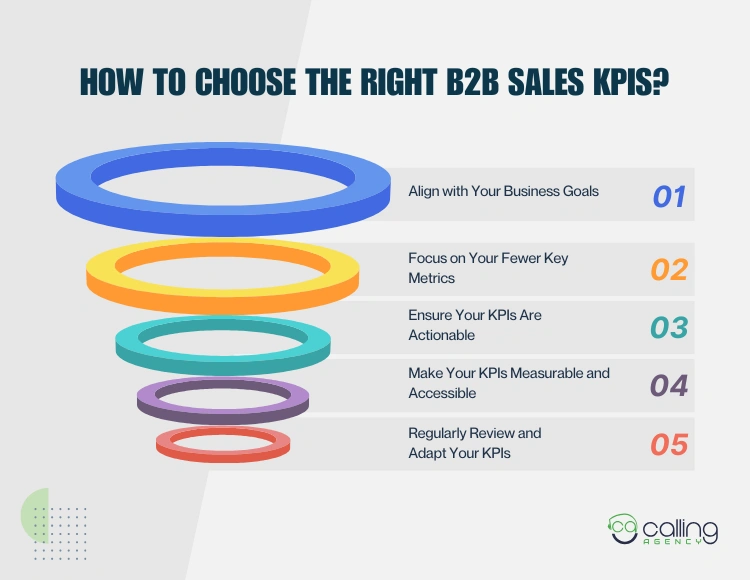
Align with Your Business Goals
- Identify your company’s important and strategic objectives, like increasing sales revenue, expanding into new markets, etc.
- So that your chosen sales KPI can directly contribute to your determined and broader business goals, ensuring everyone is working towards the same outcomes.
Focus on Your Fewer Key Metrics
- You can focus on a set of KPIs and prioritize them to prevent information overlap and maintain your valuable insights.
- Too many metrics can divert your business focus and lead your sales to inaction. You should choose KPIs that can impact your overall business performance.
Ensure Your KPIs Are Actionable
- A good KPI isn’t just about being a number. It should trigger your specific actions, such as optimizing a particular sales funnel stage or improving your lead quality.
- When you’re choosing a KPI, make sure it provides you with clear insights to help you understand where you need to strategize and make improvements.
Make Your KPIs Measurable and Accessible
- You should define your KPIs clearly and use a standard formula that measures your business progress effortlessly.
- You can use real-time dashboards within your chosen tools to view your KPIs at a glance, allowing your team to monitor performance immediately.
Regularly Review and Adapt Your KPIs
- As you know, KPIs are not stable; they’re fluid metrics that need your constant review and update based on your market changes and changing business goals.
- You need to monitor their progress regularly to make strategic adjustments, e.g., changing your lead qualification criteria, etc.
Conclusion
This blog has highlighted how a business’s overall growth and performance heavily rely on its sales performance measurements, or more precisely, sales KPIs. It’s not just tracking every single number. Rather, it’s about selecting the ones that truly matter to your business.
By focusing on key metrics such as customer lifetime value, productivity and activity, conversion rate, and relationship metrics, you are opening doors to insights that can refine your marketing strategies. Your sales team can close deals effortlessly by using such tips and optimize your business growth more effectively.


